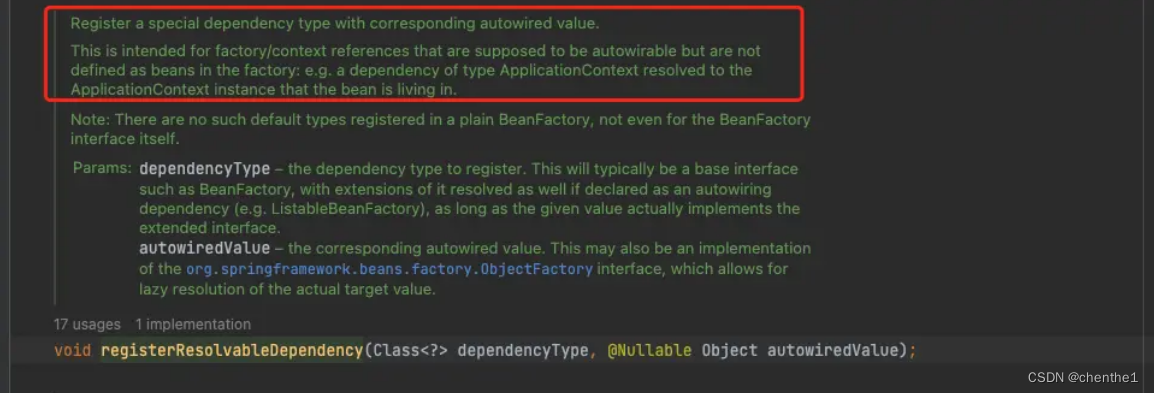问题描述:
在最近一次团队review代码时,团队成员发现有将HttpServletRequest 直接通过@Autowired注入的情况,于是大家产生了一个疑问,HttpServletRequest并非Spring中的类,且在没有手动通过@Bean的方式注入,Spring是怎么做到帮开发者完成注入的?
同时,我们知道ioc容器中默认注入的Bean是单例,而每个请求都是独立的,这样不会出问题吗?
为了研究明白为什么,我找了些资料,同时写了个简单的demo研究了下。
Demo类如下:
/**
* @author zhangrenwei
* @date 2022/8/1
* @description replace this
**/
@RestController
public class HttpServletRequestTest {
@Autowired
private HttpServletRequest httpServletRequest;
@GetMapping("/sayHi")
public void sayHi(String name) {
System.out.println(httpServletRequest.getRequestURL().toString());
JSONObject res = new JSONObject();
res.put("requestId", UUID.randomUUID().toString());
res.put("datatime", DateUtils.getDatetime());
// ReturnResult.get(res);
System.out.println("hello: " + name);
}
@PostConstruct
public void after(){
System.out.println(this.httpServletRequest);
}
}疑虑1
作为一个外部对象,HttpServletRequest为什么可以在Spring项目中通过注入的方式获取?
The PostConstruct annotation is used on a method that needs to be executed after dependency injection is done to perform any initialization. This method MUST be invoked before the class is put into service. This annotation MUST be supported on all classes that support dependency injection.
由关于@PostConstruct的描述知,@PostConstruct注解被用在执行完依赖注入之后的方法调用上,我们将断点打在上述demo的第19行,即可查看HttpServletRequest httpServletRequest实例化之后的情况。

由上图我们可以看到这个httpServletRequest对象是一个代理对象(org.springframework.web.context.support.WebApplicationContextUtils.RequestObjectFactory),该对象是一个请求的对象工厂。进入WebApplicationContextUtils这个类,Command + F12我们发现了一个往 ConfigurableListableBeanFactory工厂对象注入bean对象的方法registerWebApplicationScopes。
该方法有这样一行代码,beanFactory.``registerResolvableDependency(ServletRequest.class, new RequestObjectFactory()``);
由于HttpServletRequest正是继承自ServletRequest,这里引起了我们的关注。

ConfigurableListableBeanFactory的registerResolvableDependency方法又是用什么的呢?我们继续往下看。

使用相应的自动装配值注册一个特殊的依赖类型。
这适用于被认为可自动装配但未在工厂中定义为 bean 的工厂/上下文引用
看到这里我们就明白了,原来Spring可以为一个类注入另一个完全不同的对象值,这样从ioc容器中引用这个类的时候其实拿到的就是这个对象值。且上面的描述正好回应了,为什么我们没有手动定义HttpServletRequest却可以完成它的自动装配,秘诀就在这里。(进一步拓展思考,上面两张图一起看,除了ServletRequest.class,ServletResponse.class,HttpSession.class以及WebRequest.class类型对象,均被Spring自动注入,可以直接通过注解的方式引用)。
继续进入registerResolvableDependency方法,我们发现该方法的实现是将ServletRequest.class的依赖类型作为key, RequestObjectFactory作为装配的value,放入了resolvableDependencies这个map中。

疑虑2
HttpServletRequest注入和引用我们知道了,那么针对每个独立的请求,多线程场景下,通过自动注入的方式,HttpServletRequest 是否会有线程安全的问题呢?
我们已经知道注入拿到的HttpServletRequest返回的对象其实是下面这个
org.springframework.web.context.support.WebApplicationContextUtils.``RequestObjectFactory对象,那么它是怎么做到线程安全的呢?
我们看它的具体实现。

沿着currentRequestAttributes()方法一路点击,最终发现它的返回值,是来自org.springframework.web.context.request.RequestContextHolder#requestAttributesHolder。

requestAttributesHolder对象是一个ThreadLocal对象,由此我们明白了,Spring自动注入的HttpServletRequest能够保证请求的唯一性,原来是通过跟每个线程绑定了,从ThreadLocal中取得请求信息,由此保证的线程安全!
我们再来拓展一下,既然请求信息是从ThreadLocal中取的,那么请求信息是如何放进去的呢?
我们找到requestAttributesHolder属性的set方法,在这里打一个断点,重启系统,并发起一个http请求。

最终,通过调用堆栈信息,我们看到了org.springframework.web.filter.RequestContextFilter#doFilterInternal
中调用了initContextHolder方法,而initContextHolder方法调用了requestAttributesHolder这个ThreadLocal的set方法。
每个http请求过来会进入RequestContextFilter这个filter,在这个filter中会将request信息设置到当前的线程里。到这里,所有的谜团都解开了。
总结
我们来做一个总结,在代码中通过注解注入HttpServletRequest的方式,拿到的其实并不是真正的 HttpServletRequest,而是一个Spring项目启动时自动注入的代理对象org.springframework.web.context.support.``WebApplicationContextUtils.RequestObjectFactory。
该对象跟ServletRequest.class做了映射关联,放入了Spring管理bean注入的map中。
每次请求时,如何保证自动注入的HttpServelet请求线程安全,等价于问 org.springframework.web.context.support.WebApplicationContextUtils.``RequestObjectFactory 怎么做到的线程安全。这个类只是一个简单的对象工厂,getObject方法最终从org.springframework.web.context.request.RequestContextHolder#requestAttributesHolder这个ThreadLocal中获取请求的信息,由此做到了请求之间的隔离。
如果本篇文章对你有帮助的话,很高兴能够帮助上你。
当然,如果你觉得文章有什么让你觉得不合理、或者有更简单的实现方法又或者有理解不来的地方,希望你在看到之后能够在评论里指出来,我会在看到之后尽快的回复你。